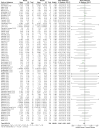The effects of dietary nitrate supplementation on endurance exercise performance and cardiorespiratory measures in healthy adults: a systematic review and meta-analysis
- PMID: 34243756
- PMCID: PMC8268374
- DOI: 10.1186/s12970-021-00450-4
The effects of dietary nitrate supplementation on endurance exercise performance and cardiorespiratory measures in healthy adults: a systematic review and meta-analysis
Abstract
Background: Nitrate supplementation is thought to improve performance in endurance sports.
Objective: To meta-analyze studies evaluating the effect of nitrate supplementation on endurance sports performance among adults.
Data sources: We searched the Cochrane Central Register of Controlled Trials (CENTRAL), MEDLINE, EMBASE, Web of Science and CINAHL without language restrictions.
Methods: We included studies that: 1) compared nitrate supplementation with placebo; 2) enrolled adults engaging in an endurance-based activity; and 3) reported a performance measure or surrogate physiologic outcome. We evaluated risk of bias using the Cochrane Collaboration tool and pooled data with a random-effects model. We used the Grading of Recommendations Assessment, Development and Evaluation (GRADE) approach to evaluate confidence in estimates.
Results: We included 73 studies (n = 1061). Nitrate supplementation improved power output (MD 4.6 watts, P < 0.0001), time to exhaustion (MD 25.3 s, P < 0.00001), and distance travelled (MD 163.7 m, P = 0.03). We found no significant difference on perceived exertion, time trial performance and work done. Nitrate supplementation decreased VO2 (MD - 0.04 L/min, P < 0.00001) but had no significant effect on VO2max or blood lactate levels.
Conclusion: The available evidence suggests that dietary nitrate supplementation benefits performance-related outcomes for endurance sports.
Keywords: Endurance exercise; Nitrate supplementation; Systematic review and meta-analysis.
© 2021. The Author(s).
Conflict of interest statement
Dr. Whitlock reports grants from Bayer, Roche, and Boeringer-Ingelheim outside the submitted work. He also reports speaker honorarium from Boeringer-Ingelheim and consultancy for AtriCure and PhaseBio outside the submitted work.
Dr. Belley-Cote reports grants from Bayer and Roche outside this submitted work.
The other authors have no conflict of interest.
Figures







Similar articles
-
The effect of six days of dietary nitrate supplementation on performance in trained CrossFit athletes.J Int Soc Sports Nutr. 2016 Nov 3;13:39. doi: 10.1186/s12970-016-0150-y. eCollection 2016. J Int Soc Sports Nutr. 2016. PMID: 27822169 Free PMC article. Clinical Trial.
-
Influence of Nitrate Supplementation on Endurance Cyclic Sports Performance: A Systematic Review.Nutrients. 2020 Jun 17;12(6):1796. doi: 10.3390/nu12061796. Nutrients. 2020. PMID: 32560317 Free PMC article.
-
Acute administration of inorganic nitrate reduces VO(2peak) in endurance athletes.Med Sci Sports Exerc. 2011 Oct;43(10):1979-86. doi: 10.1249/MSS.0b013e318217d439. Med Sci Sports Exerc. 2011. PMID: 21407132 Clinical Trial.
-
Aerobic Fitness Affects the Exercise Performance Responses to Nitrate Supplementation.Med Sci Sports Exerc. 2015 Aug;47(8):1643-51. doi: 10.1249/MSS.0000000000000577. Med Sci Sports Exerc. 2015. PMID: 25412295
-
Nitrate supplementation improves physical performance specifically in non-athletes during prolonged open-ended tests: a systematic review and meta-analysis.Br J Nutr. 2018 Mar;119(6):636-657. doi: 10.1017/S0007114518000132. Br J Nutr. 2018. PMID: 29553034
Cited by
-
Dietary Nitrate Ingestion Does Not Improve Neuromuscular Performance in Male Sport Climbers.J Hum Kinet. 2023 Apr 20;87:47-57. doi: 10.5114/jhk/161812. eCollection 2023 Apr. J Hum Kinet. 2023. PMID: 37229410 Free PMC article.
-
A comparison of oral microbiome composition between highly trained competitive athletes and untrained controls.Sci Rep. 2025 Aug 28;15(1):31736. doi: 10.1038/s41598-025-16835-3. Sci Rep. 2025. PMID: 40877538 Free PMC article.
-
Short-Term Beetroot Juice Supplementation Enhances Strength, Reduces Fatigue, and Promotes Recovery in Physically Active Individuals: A Randomized, Double-Blind, Crossover Trial.Nutrients. 2025 May 19;17(10):1720. doi: 10.3390/nu17101720. Nutrients. 2025. PMID: 40431460 Free PMC article. Clinical Trial.
-
Does Beetroot Supplementation Improve Performance in Combat Sports Athletes? A Systematic Review of Randomized Controlled Trials.Nutrients. 2023 Jan 12;15(2):398. doi: 10.3390/nu15020398. Nutrients. 2023. PMID: 36678270 Free PMC article.
-
The Effects of Nitrate Supplementation on Performance as a Function of Habitual Dietary Intake of Nitrates: A Randomized Controlled Trial of Elite Football Players.Nutrients. 2023 Aug 25;15(17):3721. doi: 10.3390/nu15173721. Nutrients. 2023. PMID: 37686753 Free PMC article. Clinical Trial.
References
-
- World Health Organization. Global Recommendations on Physical Activity for Health. Geneva: WHO Press; 2010. - PubMed
Publication types
MeSH terms
Substances
LinkOut - more resources
Full Text Sources
Medical
